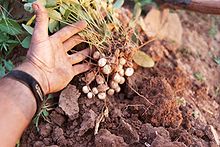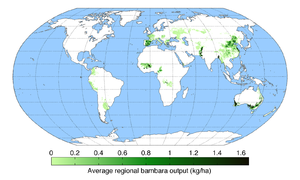- Bambara groundnut
-
Bambara groundnut 
Scientific classification Kingdom: Plantae (unranked): Angiosperms (unranked): Eudicots (unranked): Rosids Order: Fabales Family: Fabaceae Genus: Vigna Species: V. subterranea Binomial name Vigna subterranea
(L.) Verdc.The Bambara groundnut (or Bambarra groundnut) is a member of the family Fabaceae. According to some authors it is Voandzeia subterranea, but others place it in Vigna. The plant originated in West Africa. Still a traditional food plant in Africa, this little-known vegetable has potential to improve nutrition, boost food security, foster rural development and support sustainable landcare.[1] The bambara groundnut ripens its pods underground, much like the peanut (also called a groundnut). They can be eaten fresh or boiled after drying.
The original local name for Bambara nut is cokon (Bamanankan). Bambara groundnuts are also known as jugo beans or in Swahili, njugumawe. In the Republic of Zambia, bambara groundnuts are known as either ntoyo (ciBemba),katoyo (kiKaonde), or mbwiila (chiTonga). In Shangaan they are known as tindluwa. In Malagasy they are known as voanjobory. In Hausa language it is variously referred to as "Gurjiya" or "Kwaruru". In Goemai language of Plateau State of Northern Nigeria it is known as "Kwam", and Kanuri people refer to it as "Ngamgala". In Indonesia it is called "kacang bogor", which literally means "Bogor peanut", because this plant is widely cultured in Bogor, West Java. In the Shona language of Zimbabwe it is known as "Nyimo", and "indlubu" in the ndebele language. In the Ibo language in eastern Nigeria, it is commonly known as "Okpa". In the Northern part of Yoruba, it is commonly known as "Epa-kuta", and in the Gha Language, spoken by the people in Greater Accra, Ghana, the Bambara Bean is called "Akwei".
Contents
Agronomic aspects
Origin and regions of cultivation
The origin of the Bambara groundnut is West Africa[2] and the region of cultivation is Sub-Saharan Africa's warm tropics.[3]
Importance in the World Food System
Bambara groundnut represents the third[4] most important grain legume in semi-arid Africa. “It is resistant to high temperature and is suitable for marginal soils where other leguminous crops cannot be grown”.[5] In addition, it makes very little demand on the soil[6] and has a high nutritive value with 65% carbohydrate[7] and 18% protein[7] content. For these reasons it is not prone to the risk of total harvest failure even in low and uncertain rainfall regions. "Due to its high protein value it is a very important crop for poorer people in Africa who cannot afford expensive animal protein."[6]
Product use
The seeds are used for food and beverage due to its high protein content[8] and for digestive system applications.[8] The entire plant is known for soil improvement[8] due to nitrogen fixation.
Soil requirements
Optimal soils for Bambara groundnut production are sandy soils to prevent water lodging. optimal soil depth is between 50 and 100 cm,[8] with a light soil texture.[8] soil fertility should be low[8] and soil pH is best suited between 5 and 6.5[8] and should not by lower than 4.3[8] or higher than 7.[8]
Climate requirements
The production is best suited between a latitude of 20° - 30°,[8] i.e. the tropical wet and dry (Aw)[8] and the subtropical dry summer (Cs)[8] climate zones. Optimal temperature is between 19°C[8] and 30°C.[8] Temperatures below 16°C[8] and above 38°C[8] are not suited for the production of bambara groundnut. The bambara groundnut is very drought resistant.[3] The minimal annual rainfall requirement is about 300 mm[8] and optimal annual rainfall is between 750 mm[8] and 1400 mm[8] and should not exceed 3000 mm.[8]
Cropping system
The cropping system is semi-permanent[8] and the Bambara groundnut can be cultivated as single crop or as intercrop.[8] Best suited intercrops are sorghum,[8] millet,[8] maize,[8] groundnut,[8] yams[8] and cassava.[8]
Bambara groundnut is mainly cultivated as intercrop, however the planting density varies between 6 to 29 plants per square meter[9]. For woodland savannas of Côte d'Ivoire the highest yield is attainable with a plant density of 25[10] plants per square meter.
Fertilization
Since Bamabara groundnut is usually intercropped, no fertilizer is applied. A yield of 1000 kg seed and 925 kg leaves remove 55.7 kg N,[11] 26.2 kg K,[11] 25.1 kg C,[11] 7.8 kg P[11] and 6.6 kg Mg.[11] Since Bambara groundnut is a legume, phosphor is the most important nutrient. An application rate of 60 kg/ha[12] of P2O5 is recommended for bambara groundnut in Yola, Adamawa State Nigeria.
Production
World production of Bambara groundnut increased from 29'600 tonnes[13] in 1961 to 79'160 tonnes[13] in 2008, while the yield during this period did not increase. "As an under-utilised crop,bambara groundnut has not received sustained research"[14] until the recent years and therefor no yield increase occurred.
Production Year 2008 (Source FAOSTAT)[13] Area Harvested (Ha) Yield (kg/ha) Production (tonnes)  Burkina Faso
Burkina Faso44'000 864 38'000  Cameroon
Cameroon12'000 833 10'000  Democratic Republic of the Congo
Democratic Republic of the Congo23'000 442 10'160  Mali
Mali28'000 750 21'000 World 107'000 740 79'160 Pest & Diseases
Pest and diseases are not considered to be a serious problem for Bambara groundnut.[11]
Reported diseases[11]:
- Leaf spot (Cerscospora canescens & Phyllosticta voandzeia)
- Powdery mildew (Erysiphe sp.)
- Wilt (Fusarium sp.)
- Leaf blotch (Phomopsis sp.)
- Stem rot (Scleorotium rolfsii)
Reported pests[11]:
- Aphids (Aphis sp.)
- Bruchids (Callosobruchus sp.)
- Leaf hoppers (Hilda patruelis)
- Termites
- Root-knot nematodes (Meloidogyne javanica)
Physiology
Growth
The growth cycle is between (min-max) 90–180 days[8] and under optimal conditions the cycle is about 120–150 days[3] to pod maturity. Flowers appear 40–60 days[3] after planting. 30 days[3] after pollination the pod reaches maturity and during another 10 days[3] the seeds fully develop.
Generative reproduction
Generative reproduction is for the Bambara groundnut autogamous[3] (self-fertilization) and cleistogamous[3] (self-pollinating).
References
- ^ National Research Council (2006-10-27). "Bambara Bean". Lost Crops of Africa: Volume II: Vegetables. Lost Crops of Africa. 2. National Academies Press. ISBN 978-0-309-10333-6. http://books.nap.edu/openbook.php?record_id=11763&page=53. Retrieved 2008-07-15.
- ^ Hepper, FN (1963). "Plants of the 1957-58 West Africa Expedition II: The bambara groundnut (Voandzeia subterranea) and Kersting’s groundnut (Kerstingiella geocarpa) wild in West Africa". Kew Bulletin 16 (3): 395–407. JSTOR 4114681.
- ^ a b c d e f g h Nichterlein, Karin. "Vigna subterranea". Ecoport. http://ecoport.org/ep?Plant=10830&entityType=PL****&entityDisplayCategory=full. Retrieved 16 March 2011.
- ^ Ocran, V. K, (1998). Seed Management Manual for Ghana. Accra Ghana: MOFA.
- ^ Yamaguchi, M (1983). World Vegetables. New York: Van Nostrand Reinhold.
- ^ a b Baryeh, E.A. (2001). "Physical properties of bambara groundnuts". Journal of food engineering 47: 321–326. http://www.sciencedirect.com/science?_ob=MImg&_imagekey=B6T8J-41V351P-C-17&_cdi=5088&_user=791130&_pii=S0260877400001369&_origin=gateway&_coverDate=03%2F31%2F2001&_sk=999529995&view=c&wchp=dGLbVzz-zSkzS&md5=a6b1b5de6c633f025ce7f020568f50eb&ie=/sdarticle.pdf. Retrieved 03.05.2011.
- ^ a b Doku, E.V. (1995). Proceedings of the Workshop on Conservation and Improvement of Bambara groundnut (Vigna subterranean (L.). Harare Zimbabwe: University of Ghana.
- ^ a b c d e f g h i j k l m n o p q r s t u v w x y z aa ab ac "Data sheet Vigna subterranea". Ecocrop. FAO. http://ecocrop.fao.org/ecocrop/srv/en/dataSheet?id=10830. Retrieved 16 March 2011.
- ^ Rassel, A (1960). "Voandzou, Voandzeia subterranea Thouars, and its cultivation in Kwango". Bull. agric. Congo belge 51: 1–26. http://www.cabdirect.org/abstracts/19601403615.html?freeview=true. Retrieved 16 March 2011.
- ^ KOUASSI, N’. J; I. A. ZORO BI (2010). "EFFECT OF SOWING DENSITY AND SEEDBED TYPE ON YIELD AND YIELD COMPONENTS IN BAMBARA GROUNDNUT (VIGNA SUBTERRANEA) IN WOODLAND SAVANNAS OF COTE D’IVOIRE". Experimental Agriculture 46: 99–110. doi:10.1017/S0014479709990494. http://journals.cambridge.org/action/displayFulltext?type=1&fid=6698056&jid=EAG&volumeId=46&issueId=01&aid=6698048. Retrieved 16 March 2011.
- ^ a b c d e f g h Mkandawire, Ceasar H (2007). "Review of Bambara Groundnut (Vigna subterranea (L.) Verdc.) Production in Sub-Sahara Africa". Agricultural Journal 2 (4): 464–470. doi:10.3923/aj.2007.464.470. http://medwelljournals.com/abstract/?doi=aj.2007.464.470. Retrieved 16 March 2011.
- ^ Toungos, M.D.; A.A. Sajo and D.T. Gungula (2009). Agricultural Journal 4 (1): 14–21. doi:10.3923/aj.2009.14.21. http://www.medwelljournals.com/fulltext/?doi=aj.2009.14.21. Retrieved 16 March 2011.
- ^ a b c "FAOSTAT". FAO. http://faostat.fao.org/site/567/DesktopDefault.aspx?PageID=567#ancor. Retrieved 16 March 2011.
- ^ Massawe, F.J.; S.S. Mwale, S.N. Azam-Ali and J.A. Roberts (2005). "Breeding in Bambara groundnut (Vigna subterranea (L.) Verdc.): strategic considerations". African Journal of Biotechnology 4 (6): 463–471. http://www.academicjournals.org/ajb/PDF/Pdf2005/Jun/Massawe%20et%20al.pdf. Retrieved 03.05.2011.
External links
- Bambara Groundnut -- Voandzeia subterranea (L.) Thouars
- Bambara Groundnut ... a Link from the Past and Resource for the Future
- "Vigna subterranea". Integrated Taxonomic Information System. http://www.itis.gov/servlet/SingleRpt/SingleRpt?search_topic=TSN&search_value=506274.
- Vigna subterranea in West African plants - A Photo Guide.
{Bambara nut: Originated yoruba name is Epa-kuta and it has a various way of praparation as food}
Categories:- Vigna
- Edible legumes
Wikimedia Foundation. 2010.



